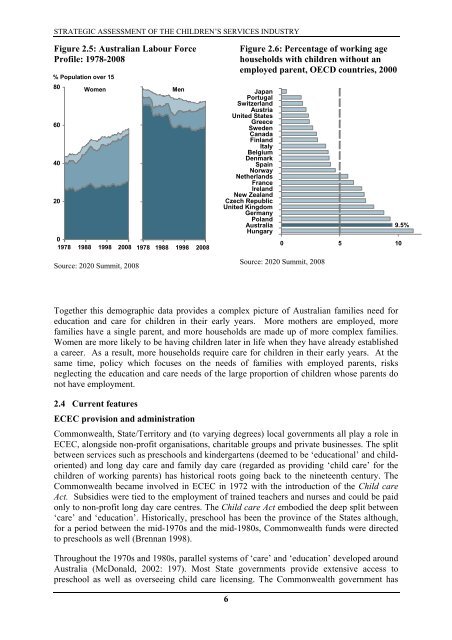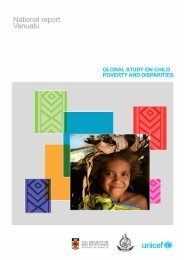A Strategic Assessment of the Children's Services Industry
A Strategic Assessment of the Children's Services Industry
A Strategic Assessment of the Children's Services Industry
- No tags were found...
You also want an ePaper? Increase the reach of your titles
YUMPU automatically turns print PDFs into web optimized ePapers that Google loves.
STRATEGIC ASSESSMENT OF THE CHILDREN’S SERVICES INDUSTRYFigure 2.5: Australian Labour ForcePr<strong>of</strong>ile: 1978-2008% Population over 1580604020Women01978 1988 1998 2008Source: 2020 Summit, 2008Men1978 1988 1998 2008Figure 2.6: Percentage <strong>of</strong> working agehouseholds with children without anemployed parent, OECD countries, 2000JapanPortugalSwitzerlandAustriaUnited StatesGreeceSwedenCanadaFinlandItalyBelgiumDenmarkSpainNorwayNe<strong>the</strong>rlandsFranceIrelandNew ZealandCzech RepublicUnited KingdomGermanyPolandAustraliaHungary0 5 10Source: 2020 Summit, 20089.5%Toge<strong>the</strong>r this demographic data provides a complex picture <strong>of</strong> Australian families need foreducation and care for children in <strong>the</strong>ir early years. More mo<strong>the</strong>rs are employed, morefamilies have a single parent, and more households are made up <strong>of</strong> more complex families.Women are more likely to be having children later in life when <strong>the</strong>y have already establisheda career. As a result, more households require care for children in <strong>the</strong>ir early years. At <strong>the</strong>same time, policy which focuses on <strong>the</strong> needs <strong>of</strong> families with employed parents, risksneglecting <strong>the</strong> education and care needs <strong>of</strong> <strong>the</strong> large proportion <strong>of</strong> children whose parents donot have employment.2.4 Current featuresECEC provision and administrationCommonwealth, State/Territory and (to varying degrees) local governments all play a role inECEC, alongside non-pr<strong>of</strong>it organisations, charitable groups and private businesses. The splitbetween services such as preschools and kindergartens (deemed to be ‘educational’ and childoriented)and long day care and family day care (regarded as providing ‘child care’ for <strong>the</strong>children <strong>of</strong> working parents) has historical roots going back to <strong>the</strong> nineteenth century. TheCommonwealth became involved in ECEC in 1972 with <strong>the</strong> introduction <strong>of</strong> <strong>the</strong> Child careAct. Subsidies were tied to <strong>the</strong> employment <strong>of</strong> trained teachers and nurses and could be paidonly to non-pr<strong>of</strong>it long day care centres. The Child care Act embodied <strong>the</strong> deep split between‘care’ and ‘education’. Historically, preschool has been <strong>the</strong> province <strong>of</strong> <strong>the</strong> States although,for a period between <strong>the</strong> mid-1970s and <strong>the</strong> mid-1980s, Commonwealth funds were directedto preschools as well (Brennan 1998).Throughout <strong>the</strong> 1970s and 1980s, parallel systems <strong>of</strong> ‘care’ and ‘education’ developed aroundAustralia (McDonald, 2002: 197). Most State governments provide extensive access topreschool as well as overseeing child care licensing. The Commonwealth government has6
















